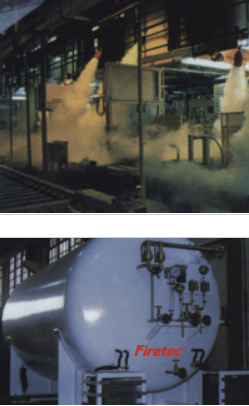Carbon Dioxide (CO2) is utilised, in fire fighting, for its several positive characteristics, such as: efficacy,cleanliness, low system and operating costs, possibility to carry out both total flooding and, in particular cases, local application systems.
Normally stored in a liquid state, in cylinders under pressure, carbon dioxide passes to a gaseous and dry ice state (very fine particles) very rapidly, that is to say as soon as it is discharged and, therefore, can expand.
The carbon dioxide systems are usually of a high pressure type and the extinguishing agent (CO2) is contained in cylinders, at ambient temperature. For noticeable dimension systems, however, this solution is not the most convenient, due to both economic and space reasons; the cylinders for these systems, in fact, are many and it is necessary to have a sufficiently wide area to house them. These are the main reasons why the protection of considerable volume risks is nowadays carried out using tow pressure systems.
In low pressure systems (18-20 bar), carbon dioxide is stored, always in a Liquid state, in one single container, at a temperature of approx. -18℃.
In reality, this is a double container, as the tank holding carbon dioxide is, in its turn, inserted into another tank, from which it is separated by an interspace. The latter is fitted with expanded pearlite and, subsequently, hard vacuum is created.
Some refrigerating units ensure maintenance of the design temperature, normally of - 18℃, at which the vapour pressure of carbon dioxide is of approx. 18 bar and, therefore, such as to allow construction of relatively cheap tanks, but also guarantee a discharge time falling within the values required by the applicable regulations.
Advantages
■ Vacuum ensures a higher degree of thermal insulation
■ Vacuum implies no need for maintenance and efficacy remains unaltered
■ Vacuum avoids problems related to condensate.


